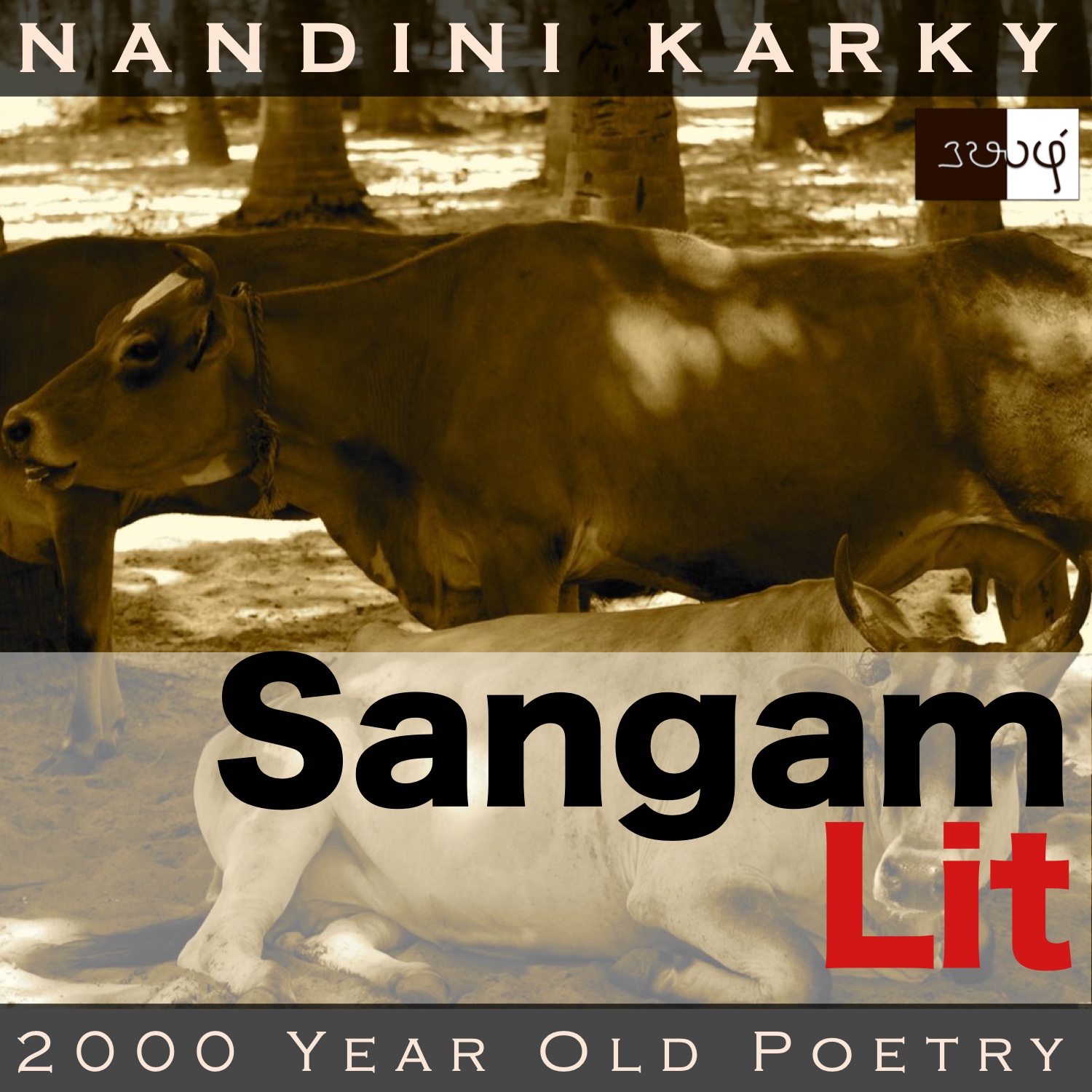Podcast: Play in new window | Download
Subscribe: Apple Podcasts | Spotify | Amazon Music | Android | iHeartRadio | TuneIn | RSS | More

In this episode, we listen to a lady’s angst as evening descends, as portrayed in Sangam Literary work, Kurunthogai 344, penned by Kurungudi Maruthanaar. The verse is situated in the forests of ‘Mullai’ and speaks in the voice of the lady to the confidante, as the man continues to be parted away, in his quest for wealth.
நோற்றோர் மன்ற-தோழி!-தண்ணெனத்
தூற்றும் துவலைப் பனிக் கடுந் திங்கள்
புலம் பயிர் அருந்த அண்ணல் ஏற்றொடு
நிலம் தூங்கு அணல வீங்கு முலை செருத்தல்
பால் வார்பு, குழவி உள்ளி, நிரை இறந்து,
ஊர்வயின் பெயரும் புன்கண் மாலை,
அரும் பெறல் பொருட் பிணிப் போகிப்
பிரிந்து உறை காதலர் வர, காண்போரே.
‘Blessed are they, not me’ is the core thought of this verse. The opening words ‘நோற்றோர் மன்ற-தோழி’ meaning ‘They must have performed penances, my friend’ reflects the perception of good fortune in others. Season is revealed by ‘பனிக் கடுந் திங்கள்’ meaning ‘a harsh and cold day’. In the phrase ‘நிலம் தூங்கு அணல’, we find a striking sketch of an Indian cattle, for it means ‘a dewlap that hangs down to the ground’. Although I have seen cows many, this is the first time, I have paid attention to the mentioned dewlap, which is the loose skin that hangs down below a cattle’s throat, referred to as ‘அணல்’ in this Sangam song. In contemporary Tamil, this part is referred to as ‘தாடி’ which also means ‘a beard’. More about this shortly! We learnt of the season in the previous reference, and now, the time of the day becomes evident in ‘புன்கண் மாலை’ meaning ‘suffering-soaked evening’. Ending with the words ‘பிரிந்து உறை காதலர் வர, காண்போரே’, which means ‘those who see their separated lovers return’, the verse bids us to listen with empathy.
An evening on a cold day – Indeed, a sad time for those separated! The context reveals that the man and lady were leading a married life, when the man parted away to gather wealth. As days pass by, the lady languishes in his absence and the confidante advises her to bear better with the man’s separation. In response, the lady says to her friend, “They have done some penance, for sure, my friend! As a drizzle spreads moisture on this harsh and cold day, the cow had left with its respectable bull to feed on the grass in the forest ground. Now, with its dewlap touching the ground and its swollen udders spilling milk, the cow thinks of its calf and crossing the herd, rushes into the village, during this suffering-filled evening hour. At this time, there are those who get to see their lovers, who had parted away because of their affliction to attain that hard-to-get wealth, return. They are indeed the ones who have done penance!” With these words, the lady expresses how she finds herself in an unfortunate situation, with the man staying away, even during that time when it was impossible to remain parted.
Yet another song of separation – let’s delve in, to see if there’s something new to learn! The lady starts by talking about others who have done penance, and instead of immediately saying who they are, she instead talks about a cow. As drops of rain drizzled down on that cold day, this cow was taken along with the bull to graze on the forest grass outside the village. Presenting a portrait of the cow, the lady points to how this cow stands, with its dewlap touching the ground, and its udders, swelling with milk, no doubt because it has recently given birth. Those udders are in such an overflowing state that milk leaks and spills below. At this time, the cow thinks of its calf and rushes towards the village, the lady tells us. This scene is mentioned to denote the dreadful evening hour. And, at this time, those women, who get to see their wealth-seeking husbands return home, must have done penances many, the lady concludes.
Others are lucky and fortunate, I don’t seem to be there, is the lament of this lady. Hopefully her friend will have the right words to cheer her up at that poignant hour. Let’s turn our attention to the portrait of the cow the lady has painted for us, and zoom on to that dewlap, the folds of skin on the cow’s neck. While researching more about this, I learnt that a large dewlap, as sketched by this Sangam verse, is characteristic of native breeds of cattle in India, also called as Zebu cattle. To name a few, these are the Kangeyam, Nellore, Bargur and Gir breeds. That’s why the dewlap sounds so exotic, for most of the pictures of cattle that we get to see belong to Western breeds that do not have this prominent feature.
Reading more about this, I found that in the Keeladi excavations, numerous cattle skeleton were found. When analysing these finds, it was discovered that these cattle belong to the species of ‘Bos Indicus’, the scientific name of these Zebu cattle. All these references jogged my memory, and I suddenly recollected having seen something similar to this, in relation to the Indus Valley Civilisation excavations. Searching on these lines, I was thrilled to locate the Bull seal of Harappa, featuring this very Zebu bull, with a huge, layered dewlap. That Harappa seal seemed to me like the perfect visual for the words in this Sangam verse. In both subtle and striking ways, we do keep finding links between the Indus Valley Civilisation and that of the ancient Tamils, who penned these intricate verses. Every day, it’s verbal excavation at Sangam Lit and delighted that today’s find of this cattle’s dewlap made us reflect on so many layers of our ancient past!




One comment on “Kurunthogai 344 – In the trail of a cow”